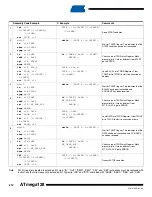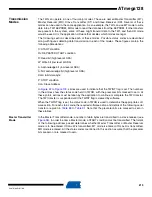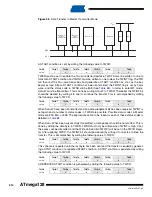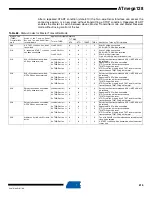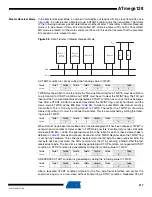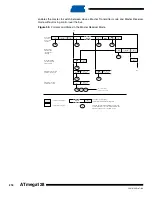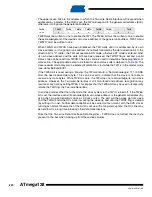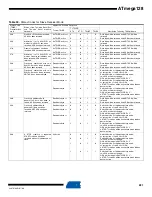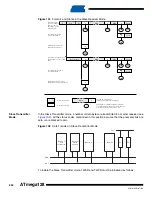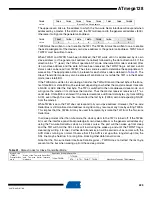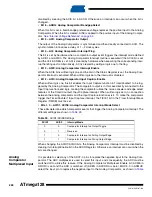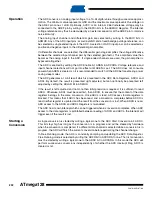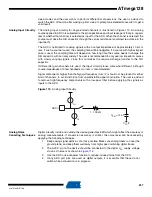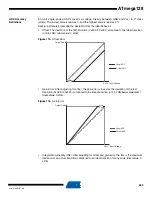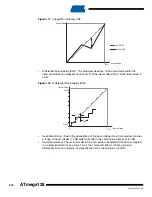
225
2467S–AVR–07/09
ATmega128
Status $F8 indicates that no relevant information is available because the TWINT flag is not set.
This occurs between other states, and when the TWI is not involved in a serial transfer.
Status $00 indicates that a bus error has occurred during a Two-wire Serial Bus transfer. A bus
error occurs when a START or STOP condition occurs at an illegal position in the format frame.
Examples of such illegal positions are during the serial transfer of an address byte, a data byte,
or an acknowledge bit. When a bus error occurs, TWINT is set. To recover from a bus error, the
TWSTO flag must set and TWINT must be cleared by writing a logic one to it. This causes the
TWI to enter the not addressed slave mode and to clear the TWSTO flag (no other bits in TWCR
are affected). The SDA and SCL lines are released, and no STOP condition is transmitted.
Combining Several
TWI Modes
In some cases, several TWI modes must be combined in order to complete the desired action.
Consider for example reading data from a serial EEPROM. Typically, such a transfer involves
the following steps:
1.
The transfer must be initiated
2.
The EEPROM must be instructed what location should be read
3.
The reading must be performed
4.
The transfer must be finished
Note that data is transmitted both from master to slave and vice versa. The master must instruct
the slave what location it wants to read, requiring the use of the MT mode. Subsequently, data
must be read from the slave, implying the use of the MR mode. Thus, the transfer direction must
be changed. The master must keep control of the bus during all these steps, and the steps
should be carried out as an atomical operation. If this principle is violated in a multimaster sys-
tem, another master can alter the data pointer in the EEPROM between steps 2 and 3, and the
master will read the wrong data location. Such a change in transfer direction is accomplished by
transmitting a REPEATED START between the transmission of the address byte and reception
of the data. After a REPEATED START, the master keeps ownership of the bus. The following
figure shows the flow in this transfer.
Figure 104.
Combining Several TWI Modes to Access a Serial EEPROM
Multi-master
Systems and
Arbitration
If multiple masters are connected to the same bus, transmissions may be initiated simultane-
ously by one or more of them. The TWI standard ensures that such situations are handled in
such a way that one of the masters will be allowed to proceed with the transfer, and that no data
Table 92.
Miscellaneous States
Status Code
(TWSR)
Prescaler Bits
are 0
Status of the Two-wire Serial
Bus and Two-wire Serial Inter-
face Hardware
Application Software Response
Next Action Taken by TWI Hardware
To/from TWDR
To TWCR
STA
STO
TWINT
TWEA
$F8
No relevant state information
available; TWINT = “0”
No TWDR action
No TWCR action
Wait or proceed current transfer
$00
Bus error due to an illegal
START or STOP condition
No TWDR action
0
1
1
X
Only the internal hardware is affected, no STOP condi-
tion is sent on the bus. In all cases, the bus is released
and TWSTO is cleared.
Master Transmitter
Master Receiver
S = START
Rs = REPEATED START
P = STOP
Transmitted from master to slave
Transmitted from slave to master
S
SLA+W
A
ADDRESS
A
Rs
SLA+R
A
DATA
A
P


